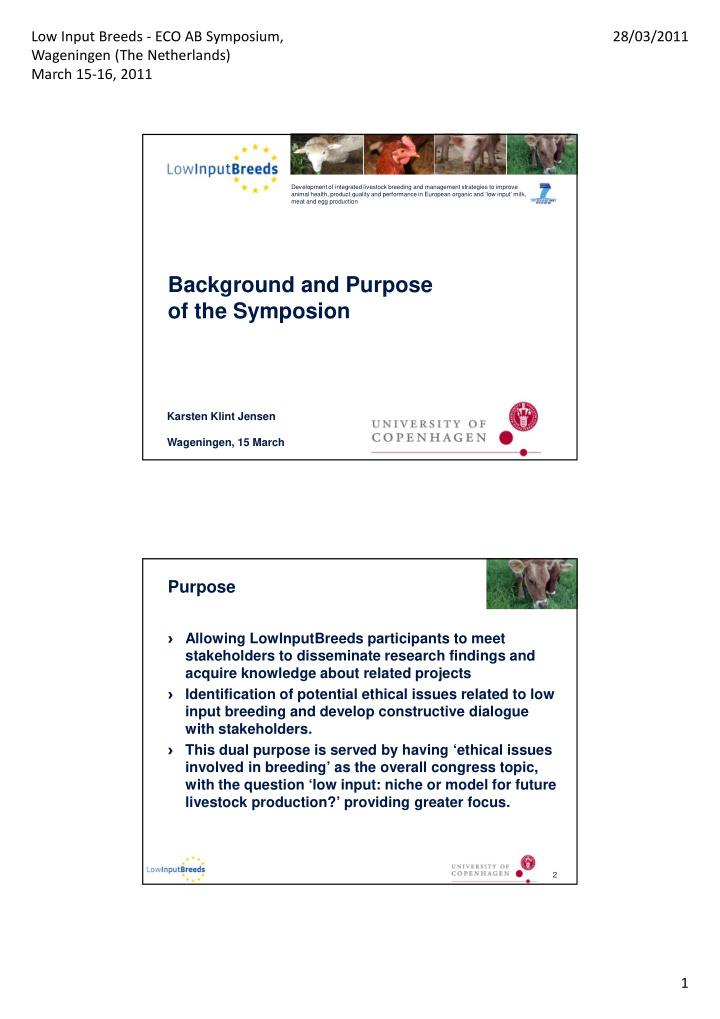



Low Input Breeds - ECO AB Symposium, 28/03/2011 Wageningen (The Netherlands) March 15-16, 2011 Development of integrated livestock breeding and management strategies to improve animal health, product quality and performance in European organic and ‘low input’ milk, meat and egg production Background and Purpose of the Symposion Karsten Klint Jensen Wageningen, 15 March Purpose � Allowing LowInputBreeds participants to meet stakeholders to disseminate research findings and acquire knowledge about related projects � Identification of potential ethical issues related to low input breeding and develop constructive dialogue with stakeholders. � This dual purpose is served by having ‘ethical issues involved in breeding’ as the overall congress topic, with the question ‘low input: niche or model for future livestock production?’ providing greater focus. 2 1
Low Input Breeds - ECO AB Symposium, 28/03/2011 Wageningen (The Netherlands) March 15-16, 2011 Ethical Impact Assessment � An ethical assessment of a practice, such as an instance of low input animal production, is concerned with, � firstly, an evaluation on the impact of the practice on all affected parties, as compared with the impact of available alternatives; and � secondly, whether the practice involves actions that could be considered wrong in themselves. � In order to perform an impact assessment, more precise evaluation criteria have to be defined: � what exactly make up good or bad impacts? 3 Ethical Impact Assessment � An ethical assessment of a practice, such as an instance of low input animal production, is concerned with, � firstly, an evaluation on the impact of the practice on all affected parties, as compared with the impact of available alternatives; and � secondly, whether the practice involves actions that could be considered wrong in themselves. � In order to perform an impact assessment, more precise evaluation criteria have to be defined: � what exactly make up good or bad impacts? 4 2
Low Input Breeds - ECO AB Symposium, 28/03/2011 Wageningen (The Netherlands) March 15-16, 2011 Animal Ethics � Animal production is a practice characterized by using animals for the benefits of humans. � Given that the practice of using animal is considered acceptable, the main ethical problems concerning animals are: to which purposes, and under which conditions can they be used? � The challenge is to strike the right balance between human interests and animal welfare. 5 Outdoor Animals � It is almost a defining characteristic of low input animal production that the animals are allowed freedom of movement, and � much of the time they are kept outdoors or at least given access to outdoor areas. � Very few people would deny that this is huge advantage for the animals in terms of welfare. 6 3
Low Input Breeds - ECO AB Symposium, 28/03/2011 Wageningen (The Netherlands) March 15-16, 2011 The Other Side of the Coin � To allow the animals this freedom also involves costs, e.g.: � Aggressive behaviour � Higher mortality � Exposure to pathogens and parasites � Extreme weather conditions. � More difficult to inspect and control the animals � These problems may involve both animals and producers. � Addressing them is the principal task of LIB. � The ethical challenge is to strike the right balance between the interests of humans and animals. 7 Values Restrict Feasible Solutions � Through its fundamental values, low input production not only commits itself to certain practices which define its identity � From this identity also follows further restrictions in dealing with problems, for instance: � Restrictions on use of medicine � Ban on mutilations � Exclusion of cross breeding � It is important for LIB to understand and clarify the precise nature of the value based restrictions on feasible practices. 8 4
Low Input Breeds - ECO AB Symposium, 28/03/2011 Wageningen (The Netherlands) March 15-16, 2011 Higher Expectations � Because low input animal production systems identify themselves by their own value based choice of standards, they also raise higher expectations among consumers � One consequences is that addressing the problems of animal welfare that are specific for low input production is a matter of some urgency � Another consequence is that practices which to a large extent are shared with high input production, may pose a greater challenge for low input production because of the higher expectations. 9 Conclusion � The ethical impact assessment is a matter of, � firstly, identifying ‘concerns’, i.e. the issues that enter into the balancing of human and animal interests; and, � secondly, to assess how the balance is affected through different alternative actions. � The actions under assessment are the research strategies of LIB: � How do these strategies affect the balance of interests between humans and animals? � How do they relate to the basic values of the relevant production system? 10 5
Low Input Breeds - ECO AB Symposium, 28/03/2011 Wageningen (The Netherlands) March 15-16, 2011 The Workshops � 14.00-14.15: Aims of the Breeding Research in the LowInputBreeds Project and the Methods to be Used � Subproject 1 (Dariy Cows and Beef Cattle) Filippo Biscarini, University of Göttingen and Sven König, University of Kassel � Subproject 2 (Sheep) Hervé Hoste, INRA � Subproject 3 (Pigs) Jan Merks, Institute for Pig Genetics IPG � Subproject 4 (Laying hens) Ferry Leenstra, Livestock Research, Wageningen University � 14.15 -14.30: Ethical Problems and Breeding Goals � Subproject 1 (Dariy Cows and Beef Cattle) Henner Simianer, University of Göttingen � Subproject 2 (Sheep) Smaro Sotirako, NAGREF � Subproject 3 (Pigs) Sandra Edwards, Newcastle University � Subproject 4 (Laying hens) Veronika Maurer, FiBL � 14.30-14.45 Critical Comment � Subproject 1 (Dariy Cows and Beef Cattle), Wytze Nauta, Louis Bolk Institute, coordinator ECO-AB � Subproject 2 (Sheep) Joanne Conington, Scottish Agricultural College � Subproject 3 (Pigs) Anna Wallenbeck, Swedish University of Agricultural Sciences � Subproject 4 (Laying hens) Gerard Albers, ISA Hendrix Genetics 11 I gratefully acknowledge co-funding from the European Commission, under the Seventh Framework Programme for Research and Technological Development, for the Collaborative Project LowInputBreeds (Grant agreement No 222623) 12 6
Recommend
More recommend